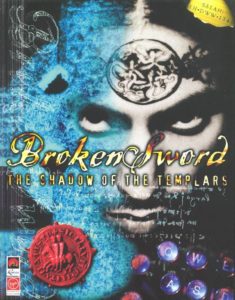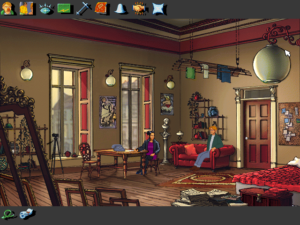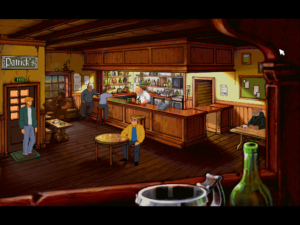The games of Revolution Software bore the stamp of the places in which they were conceived. Work on Beneath a Steel Sky, the company’s breakthrough graphic adventure, began in Hull, a grim postindustrial town in the north of England, and those environs were reflected in the finished product’s labyrinths of polluted streets and shuttered houses. But by the time Revolution turned to the question of a follow-up, they had upped stakes for the stately city of York. “We’re surrounded by history here,” said Revolution co-founder Tony Warriner. “York is a very historical city.” Charles Cecil, Revolution’s chief motivating force in a creative sense, felt inspired to make a very historical game.
The amorphous notion began to take a more concrete form after he broached the idea over dinner one evening to Sean Brennan, his main point of contact at Revolution’s publisher Virgin Interactive. Brennan said that he had recently struggled through Umberto Eco’s infamously difficult postmodern novel Foucault’s Pendulum, an elaborate satire of the conspiratorial view of history which is so carefully executed that its own conspiracy theories wind up becoming more convincing than most good-faith examples of the breed. Chasing a trail of literally and figuratively buried evidence across time and space… it seemed ideal for an adventure game. Why not do something like that? Perhaps the Knights Templar would make a good starting point. Thus was born Broken Sword: The Shadow of the Templars.
Our respectable books of history tell us that the Knights Templar was a rich and powerful but relatively brief-lived chivalric order of the late Middle Ages in Europe. It was founded in 1119 and torn up root and branch by a jealous King Philip IV of France and Pope Clement V in 1312. After that, it played no further role in history. Or did it?
People have been claiming for centuries that the order wasn’t really destroyed at all, that it just went underground in one sense or another. Meanwhile other conspiracy theories — sometimes separate from, sometimes conjoined with the aforementioned — have posited that the Knights left a fabulous hidden treasure behind somewhere, which perchance included even the Holy Grail of Arthurian legend.
In the 1960s, the old stories were revived and adapted into a form suitable for modern pop culture by a brilliant French fabulist named Pierre Plantard, who went so far as to plant forged documents in his homeland’s Bibliothèque Nationale. Three Anglo authors ingeniously expanded upon his deceptions — whether they were truly taken in by them or merely saw them as a moneymaking opportunity is unclear — in 1982 in the book The Holy Blood and the Holy Grail. It connected the Knights Templar to another, more blasphemous conspiracy theory: that Jesus Christ had not been celibate as stated in the New Testament, nor had his physical form actually died on the cross. He had rather run away with Mary Magdalene and fathered children with her, creating a secret bloodline that has persisted to the present day. The Knights Templar were formed to guard the holy bloodline, a purpose they continue to fulfill. Charles Cecil freely admits that it was The Holy Blood and the Holy Grail that really got his juices flowing.
It isn’t hard to see why. It’s a rare literary beast: a supposedly nonfiction book full of patent nonsense that remains thoroughly entertaining to read even for the person who knows what a load of tosh it all is. In his review of it back in 1982, Anthony Burgess famously wrote that “it is typical of my unregenerable soul that I can only see this as a marvelous theme for a novel.” Many others have felt likewise over the years since. If Umberto Eco’s unabashedly intellectual approach doesn’t strike your fancy, you can always turn to The Da Vinci Code, Dan Brown’s decidedly more populist take on the theme from 2003 — one of the most successful novels of the 21st century, the founder of a veritable cottage industry of sequels, knock-offs, and cinematic adaptations. (Although Brown himself insists that he didn’t use The Holy Blood and the Holy Grail for a crib sheet when writing his novel, pretty much no one believes him.)
For all their convoluted complexity, conspiracy theories are the comfort food of armchair historians. They state that the sweeping tides of history are not the result of diffuse, variegated, and ofttimes unease-inducing social and political impulses, but can instead all be explained by whatever shadowy cabal they happen to be peddling. It’s a clockwork view of history, A leading to B leading to C, which conveniently absolves us and our ancestors who weren’t pulling the strings behind the scenes of any responsibility for the state of the world. I’ve often wondered if the conspiratorial impulse in modern life stems at least in part from our current obsession with granular data, our belief that all things can be understood if we can just collect enough bits and bytes and analyze it all rigorously enough. Such an attitude makes it dangerously easy to assemble the narratives we wish to be true out of coincidental correlations. The amount of data at our fingertips, it seems to me, has outrun our wisdom for making use of it.
But I digress. As Burgess, Eco, and Brown all well recognized, outlandish conspiracy theories can be outrageously entertaining, and are harmless enough if we’re wise enough not to take them seriously. Add Charles Cecil to that list as well: “I was convinced a game set in the modern day with this history that resonated from Medieval times would make a very compelling subject.”
As he began to consider how to make a commercial computer game out of the likes of The Holy Blood and the Holy Grail, Cecil realized that he needed to stay well away from the book’s claims about Jesus Christ; the last thing Revolution Software or Virgin Interactive needed was to become the antichrist in the eyes of scandalized Christians all over the world. So, he settled on a less controversial vision of the Knights Templar, centering on their alleged lost treasure — a scavenger hunt was, after all, always a good fit for an adventure game — and a fairly nondescript conspiracy eager to get their hands on it for a spot of good old world domination for the sake of it.
Cecil and some of his more committed fans have occasionally noted some surface similarities between his game and The Da Vinci Code, which was published seven years later, and hinted that Dan Brown may have been inspired by the game as well as by The Holy Blood and the Holy Grail. In truth, though, the similarities would appear to be quite natural for fictions based on the same source material.
Indeed, I’ve probably already spent more time on the historical backstory of Broken Sword here than it deserves, considering how lightly it skims the surface of the claims broached in The Holy Blood and the Holy Grail and elsewhere. Suffice to say that the little bit of it that does exist here does a pretty good job of making you feel like you’re on the trail of a mystery ancient and ominous. And that, of course, is all it really needs to do.
In addition to being yet another manifestation of pop-culture conspiracy theorizing, Broken Sword was a sign of the times for the industry that produced it. Adventure games were as big as they would ever get in 1994, the year the project was given the green light by Virgin. Beneath a Steel Sky had gotten good reviews and was performing reasonably well in the marketplace, and Virgin was willing to invest a considerable sum to help Revolution take their next game to the proverbial next level, to compete head to head with Sierra and LucasArts, the titans of American adventure gaming. Broken Sword‘s final production cost would touch £1 million, making it quite probably the most expensive game yet made in Britain.
Having such a sum of money at their disposal transformed Revolution’s way of doing business. Some 50 different people in all contributed to Broken Sword, a five-fold increase over the staff hired for Beneath a Steel Sky. Artist Dave Gibbons, whose distinctive style had done so much to make the previous game stand out from the pack, was not among them, having moved on to other endeavors. But that was perhaps for the best; Gibbons was a comic-book artist, adept at crafting striking static images. Broken Sword, on the other hand, would have lots of motion, would be more of an interactive cartoon than an interactive comic.
To capture that feel, Charles Cecil went to Dublin, Ireland, where the animator Don Bluth ran the studio behind such films as The Land Before Time, All Dogs Go to Heaven, and Thumbelina. There he met one Eoghan Cahill, who had been working with Bluth for years, and got a hasty education on what separates the amateurs from the professionals in the field. Cecil:
I have to say, I didn’t take layout all that seriously. But he asked me about layout, and I showed him some of the stuff we were working on. And he looked at me and said, “This is not good enough.” I felt rather hurt. He said, “You need to see my stuff and you need to employ me.” So I had a look at his stuff, and it was so beautiful.
I said, “I think I really do need to employ you.” And indeed, he came to work at Revolution as a layout artist.
Although Don Bluth himself had nothing to do with the game, Broken Sword is as marked by the unique sensibility he inculcated in his artists as Beneath a Steel Sky is by that of Dave Gibbons. The opening movie is a bravura sequence by any standard, a tribute not only to the advantages of Super VGA graphics and CD-ROM — Revolution’s days of catering to more limited machines like the Commodore Amiga were now behind them — but to the aesthetic sophistication which Cahill brought to the project. Broken Sword‘s “pixel art,” as the kids call it today, remains mouth-wateringly luscious to look upon, something which most certainly cannot be said of the jaggy 3D productions of the mid-1990s.

The view with which the intro movie begins is a real one from the bell tower of Notre Dame Cathedral.
It’s worth dwelling on this movie a bit, for it does much to illustrate how quickly both Revolution and the industry to which they belonged were learning and expanding their horizons. Consider the stirring score by the noted film, television, and theater composer and conductor Barrington Pheloung, which is played by a real orchestra on real instruments — a growing trend in games in general at the time, which would have been unimaginable just a few years earlier for both technical and budgetary reasons.
Then, too, consider the subtle sophistication of the storytelling techniques that are employed here, from the first foreshadowing voice-over — the only dialog in the whole sequence — to the literal bang that finishes it. Right after the movie ends, you take control amidst the chaos on the sidewalk that follows the explosion. Assuming you aren’t made of the same stuff as that Notre Dame gargoyle, you’re already thoroughly invested at this point in figuring out what the heck just happened. The power of an in medias res opening like this one to hook an audience was well known to William Shakespeare, but has tended to elude many game developers. Charles Cecil:
There are two ways to start a game. You can give lots of background about a character and what he or she is doing or you can start in a way that is [in] the player’s control, and that’s what I wanted. I thought that since the player controlled the character and associated with him, I could afford to start a game without giving away a great deal about the character. So in the first scene, I didn’t want a long exposition. George is drawn into the plot unwillingly, having been caught up in an explosion, and he wants to do the right thing in finding out what was behind it.
All told, the jump in the quality of storytelling and writing from Beneath a Steel Sky to Broken Sword is as pronounced as the audiovisual leap. Beneath a Steel Sky isn’t really a poorly written game in comparison to others of its era, but the script at times struggles to live up to Dave Gibbons’s artwork. It bears the telltale signs of a writer not quite in control of his own material, shifting tones too jarringly and lapsing occasionally into awkward self-referential humor when it ought to be playing it straight.
None of that is the case with Broken Sword. This game’s writers know exactly where they want to go and have the courage of their conviction that they can get there. This is not to say that it’s dour — far from it; one of the greatest charms of the game is that it never takes itself too seriously, never forgets that it is at bottom just an exercise in escapist entertainment.
Remarkably, the improvement in this area isn’t so much a credit to new personnel as to the usual suspects honing their craft. Revolution’s games were always the vision of Charles Cecil, but, as he admits, he’s “not the world’s greatest writer.” Therefore he had relied since the founding of Revolution on one Dave Cummins to turn his broad outlines into a finished script. For Broken Sword, Cummins was augmented by a newcomer named Jonathan Howard, but the improvement in the writing cannot be down to his presence alone. The veterans at Revolution may have become harder to spot amidst the sea of new faces, but they were working as hard as anyone to improve, studying how film and television were put together and then applying the lessons to the game — but sparingly and carefully, mind you. Cecil:
When Broken Sword came out, we were riding on the back of these interactive movies. They were a disaster. The people knocking them out were being blinded; they wanted to rub shoulders with movie stars and producers, and the gaming elements were lost. They were out of touch with games. Of course, I am interested in film script-writing and I felt then and still do that there can be parallels with games. I felt we needed to learn from the movies with Broken Sword, but not mimic them. It was my intention to make Broken Sword cinematic — with great gameplay.
Revolution may have had global ambitions for Broken Sword, but it’s a deeply British game at heart, shot through with sly British humor. To properly appreciate any of that, however, we really need to know what the game is actually about, beyond the Knights Templar and international conspiracies of evil in the abstract.
Broken Sword‘s protagonist is an American abroad with the pitch-perfect name of George Stobbart, who is winningly portrayed in the original game and all four of its official sequels to date by voice actor Rolf Saxon. George is a painfully earnest everyman — or at least every-American — who in an earlier era might have been played on the silver screen by Jimmy Stewart. He wanders through the game’s foreign settings safely ensconced in the impenetrable armor of his nationality, a sight recognizable to any observer of Americans outside their natural habitat. To my mind the funniest line in the entire script comes when he’s accosted by an overzealous French police constable brandishing a pistol. “Don’t shoot!” he yells. “I’m an American!” Whole volumes of sociology and history could be written by way of unpacking those five words…
Anyway, as we saw in the movie above, the vacationing George is sitting in a Parisian café when a killer clown bombs the place to smithereens, in what seems to have been a deliberate — and unfortunately successful — act of murder against one particular patron. Earnest fellow that he is, George takes it upon himself to solve the crime, which proves to be much more than a random act of street violence. As he slowly peels the onion of the conspiracy behind it all, he has occasion to visit Ireland, Syria, Spain, and Scotland in addition to roaming the length and breadth of Paris, the home base for his investigations. And why does Paris feature so prominently? Well, it was close enough to Britain to make it easy for Revolution to visit in the name of research, but still held a powerful romantic allure for an Englishman of Cecil’s generation. “England was very poor in the 1960s and 1970s, and London was gray and drab,” he says. “Paris was smart. People walked differently and they wore brighter clothes. You sat in restaurants and ate amazing food. The mythology of Paris [in] Broken Sword came from that imagery of my younger days.”
George’s companion — constantly in research, from time to time in adventure, and potentially in romance — is one Nico, a French reporter with a sandpaper wit whom he meets at the scene of the bombing. She was originally created by the game’s writers to serve a very practical purpose, a trick that television and movie scriptwriters have been employing forever: in acting as a diegetic sounding board for George, she becomes a handy way to keep the player oriented and up to date with the ramifications of his latest discoveries, helping the player to keep a handle on what becomes a very complex mystery. In this sense, then, her presence is another sign of how Revolution’s writers were mastering their craft. “It meant we didn’t need to have lengthy one-man dialogs or 30 minutes of cut scenes,” says Charles Cecil.
The sexual tension between the oft-bickering pair — that classic “will they or won’t they?” dilemma — was initially a secondary consideration. It’s actually fairly understated in this first game, even as Nico herself is less prominent than she would later become; she spends the bulk of the game sitting in her apartment conducting vaguely defined “inquiries,” apparently by telephone, and waiting for another visit from George. [1]It’s telling that, when Revolution recently produced a “director’s cut” of the game for digital distribution, the most obvious additions were a pair of scenes where the player gets to control Nico directly, giving at least the impression that she has a more active role in the plot. Sadly, one of these takes place before the bombing in the Parisian café, rather spoiling that dramatically perfect — and perfectly dramatic — in medias res opening.
So much for the characters. Now, back to the subject of humor:
There’s the time when George tells Nico that he’s just visited the costume shop whence he believes the bomber to have rented his clown suit. “Yeah, I like it. What are you supposed to be?” she asks. Da-dum-dum!
“I didn’t hire a costume,” answers our terminally earnest protagonist. “These are my clothes and you know it.”
And then there’s Nico and (a jealous) George’s discussion with a French historian about Britain’s status during the time of the Roman Empire. “To the Romans, the Mediterranean was the center of the universe,” says the historian. “Britain was a remote, unfriendly place inhabited by blue-painted savages.”
“It hasn’t changed much,” says Nico. Da-dum-dum-dum!
“Well, they’ve stopped painting themselves blue,” says our straight man George.
“Except when they go to a football match,” deadpans Nico. Da-dum-dum-dum-dum!
You get the idea. I should say that all of this is made funnier by the performances of the voice cast, who are clearly having a grand old time turning their accents up to eleven. (Like so many Anglosphere productions, Broken Sword seems to think that everyone speaks English all the time, just in funny ways and with a light salting of words like bonjour and merci.)
And yet — and this is the truly remarkable part — the campiness of it all never entirely overwhelms the plot. The game is capable of creating real dramatic tension and a palpable sense of danger from time to time. It demands to be taken seriously at such junctures; while you can’t lock yourself out of victory without knowing it, you can die. The game walks a tenuous tightrope indeed between drama and comedy, but it very seldom loses its balance.
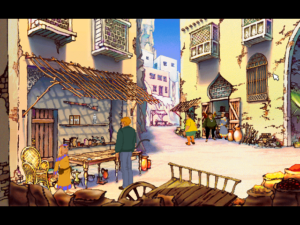
It’s hard to reconcile Broken Sword‘s Syria, a place where horror exists only in the form of Knights Templar assassins, a peddler of dodgy kebobs, and — most horrifying of all — an American tourist in sandals and knee socks, with the reality of the country of today. The civil war that is now being fought there has claimed the lives of more than half a million people and shattered tens of millions more.
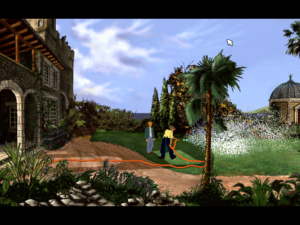
A villa in Spain with a connection to the Knights Templar and a grouchy gardener whom George will need to outwit.
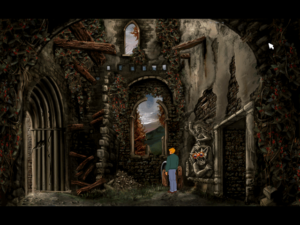
Amidst ruins of a Scottish castle fit for a work of Romantic art, on the cusp of foiling the conspirators’ nefarious plot.
Revolution spent an inordinate amount of time — fully two and a half years — honing their shot at the adventure-game big leagues. They were silent for so long that some in the British press consigned them to the “where are they now?” file. “Whatever happened to Revolution Software?” asked PC Zone magazine in January of 1996. “Two releases down the line, they seem to have vanished.”
Alas, by the time Broken Sword was finally ready to go in the fall of 1996, the public’s ardor for the adventure genre had begun to dissipate. Despite a slew of high-profile, ambitious releases, 1996 had yet to produce a million-selling hit like the previous year’s Phantasmagoria, or like Myst the year before that. Especially in the United States, the industry’s focus was shifting to 3D action-oriented games, which not only sold better but were cheaper and faster to make than adventure games. In what some might call a sad commentary on the times, Virgin’s American arm insisted that the name of Broken Sword be changed to Circle of Blood. “They wanted it to be much more ‘bloody’ sounding,” says Charles Cecil.
For all of its high production values, the game was widely perceived by the American gaming press as a second-tier entry in a crowded field plagued by flagging enthusiasm. Computer Gaming World‘s review reads as a more reserved endorsement than the final rating of four stars out of five might imply. “The lengthy conversations often drag on before getting to the point,” wrote the author. If you had told her that Broken Sword — or rather Circle of Blood, as she knew it — would still be seeing sequels published in the second decade after such adventure standard bearers as King’s Quest and Gabriel Knight had been consigned to the videogame history books, she would surely have been shocked to say the least.
Ah, yes, Gabriel Knight… the review refers several times to that other series of adventure games masterminded by Sierra’s Jane Jensen. Even today, Gabriel Knight still seems to be the elephant in the room whenever anyone talks about Broken Sword. And on the surface, there really are a lot of similarities between the two. Both present plots that are, for all their absurdity, extrapolations on real history; both are very interested in inculcating a sense of place in their players; both feature a male protagonist and a female sidekick who develop feelings for one another despite their constant bickering, and whose rapport their audience developed feelings for to such an extent that they encouraged the developers to make the sidekick into a full-fledged co-star. According to one line of argument in adventure-game fandom, Broken Sword is a thinly disguised knock-off of Gabriel Knight. (The first game of Sierra’s series was released back in 1993, giving Revolution plenty of time to digest it and copy it.) Many will tell you that the imitation is self-evidently shallower and sillier than its richer inspiration.
But it seems to me that this argument is unfair, or at least incomplete. To begin with, the whole comparison feels more apt if you’ve only read about the games in question than if you’ve actually played them. Leaving aside the fraught and ultimately irrelevant question of influence — for the record, Charles Cecil and others from Revolution do not cite Gabriel Knight as a significant influence — there is a difference in craft that needs to be acknowledged. The Gabriel Knight games are fascinating to me not so much for what they achieve as for what they attempt. They positively scream out for critical clichés about reaches exceeding grasps; they’re desperate to elevate the art of interactive storytelling to some sort of adult respectability, but they never quite figure out how to do that while also being playable, soluble adventure games.
Broken Sword aims lower, yes, but hits its mark dead-center. From beginning to end, it oozes attention to the details of good game design. “We had to be very careful, and so we went through lots of [puzzles], seeing which ones would be fun,” says Charles Cecil. “These drive the story on, providing rewards as the player goes along, so we had to get them right.” One seldom hears similar anecdotes from the people who worked on Sierra’s games.
This, then, is the one aspect of Broken Sword I haven’t yet discussed: it’s a superb example of classic adventure design. Its puzzles are tricky at times, but never unclued, never random, evincing a respect for its player that was too often lost amidst the high concepts of games like Gabriel Knight.
Of course, if you dislike traditional adventure games on principle, Broken Sword will not change your mind. As an almost defiantly traditionalist creation, it resolves none of the fundamental issues with the genre that infuriate so many. The puzzles it sets in front of you seldom have much to do with the mystery you’re supposed to be unraveling. In the midst of attempting to foil a conspiracy of world domination, you’ll expend most of your brainpower on such pressing tasks as luring an ornery goat out of an Irish farmer’s field and scouring a Syrian village for a kebob seller’s lucky toilet brush. (Don’t ask!) Needless to say, most of the solutions George comes up with are, although typical of an adventure game, ridiculous, illegal, and/or immoral in any other context. The only way to play them is for laughs.
And this, I think, is what Broken Sword understands about the genre that Gabriel Knight does not. The latter’s puzzles are equally ridiculous (and too often less soluble), but the game tries to play it straight, creating cognitive dissonances all over the place. Broken Sword, on the other hand, isn’t afraid to lean into the limitations of its chosen genre and turn them into opportunities — opportunities, that is, to just be funny. Having made that concession, if concession it be, it finds that it can still keep its overarching plot from degenerating into farce. It’s a pragmatic compromise that works.
I like to think that the wisdom of its approach has been more appreciated in recent years, as even the more hardcore among us have become somewhat less insistent on adventure games as deathless interactive art and more willing to just enjoy them for what they are. Broken Sword may have been old-school even when it was a brand-new game, but it’s no musty artifact today. It remains as charming, colorful, and entertaining as ever, an example of a game whose reach is precisely calibrated to its grasp.
(Sources: the books The Holy Blood and the Holy Grail by Michael Baigent, Richard Leigh, and Henry Lincoln and Grand Thieves and Tomb Raiders: How British Video Games Conquered the World by Magnus Anderson and Rebecca Levene; Retro Gamer 31, 63, 146, and 148; PC Zone of January 1996; Computer Gaming World of February 1997. Online sources include Charles Cecil’s interviews with Anthony Lacey of Dining with Strangers, John Walker of Rock Paper Shotgun, Marty Mulrooney of Alternative Magazine Online, and Peter Rootham-Smith of Game Boomers.
Broken Sword: The Shadow of the Templars is available for digital purchase as a “director’s cut” whose additions and modifications are of dubious benefit. Luckily, the download includes the original game, which is well worth the purchase price in itself.)
Footnotes
| ↑1 | It’s telling that, when Revolution recently produced a “director’s cut” of the game for digital distribution, the most obvious additions were a pair of scenes where the player gets to control Nico directly, giving at least the impression that she has a more active role in the plot. Sadly, one of these takes place before the bombing in the Parisian café, rather spoiling that dramatically perfect — and perfectly dramatic — in medias res opening. |
|---|
